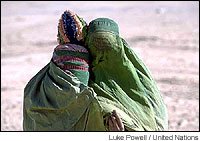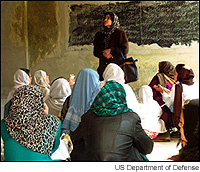Feminism, the Taliban and the Politics of Counterinsurgency
by Saba Mahmood by Charles Hirschkind
 n a cool, breezy evening in March 1999, Hollywood celebrities turned out in large numbers to show their support for the Feminist Majority's campaign against the Taliban's brutal treatment of Afghan women.
n a cool, breezy evening in March 1999, Hollywood celebrities turned out in large numbers to show their support for the Feminist Majority's campaign against the Taliban's brutal treatment of Afghan women.
The person spearheading this campaign was Mavis Leno, Jay Leno's wife, who had been catapulted into political activism when she heard about the plight of Afghan women living under the brutal regime of the Taliban.
Little did members of the Feminist Majority know that Leno would make the plight of Afghan women living under the Taliban rule a cause célèbre: not only did the Hollywood celebrities join the ranks of what came to be called the "Stop Gender Apartheid in Afghanistan" campaign, but a large number of popular women's magazines (like Glamour, Jane, Teen, etc.), in addition to feminist journals like Sojourner, off our backs and Ms., carried articles on the plight of Afghan women living under the Taliban. The Feminist Majority claims that it was their work that eventually dissuaded Unocal officials to abandon plans to develop a natural gas pipeline in Afghanistan, and convinced Hollywood-friendly Bill Clinton to condemn the Taliban regime.
Throughout, what seemed strange to us about this campaign was the studied silence on the crucial role the United States had played in creating the miserable conditions under which Afghan women were living. Even though the Feminist Majority and some of the women's journals pointed to the civil war as an important background to the current misfortune of Afghan women, there was little attempt to connect this with the massive military and economic support that the US had provided, as part of its Cold War strategy, to the most extreme of Afghan religious militant groups and which made the conditions ripe for the Taliban to come into power.

An Afghan woman and child at the Roghani refugee camp in Pakistan, December 2001.
Given its mass popularity, the Feminist Majority's campaign served as a key element in the construction of the Taliban as an enemy particularly deserving of our wrath because of their harsh treatment of women. After the September 11 attacks, the burqa-clad bodies of Afghan women became the visible sign of an invisible enemy that threatened not only us, but our entire civilization. As Laura Bush put it in her November 17, 2001, radio address to the nation: "Civilized people throughout the world are speaking out in horror--not only because our hearts break for the women and children of Afghanistan, but also because in Afghanistan, we see the world the terrorists would like to impose on the rest of us."
In the context of this intense concern for Afghan women, it is striking how silent the vast majority of Americans have been about civilian casualties that resulted from the US bombing campaign. In December 2001--two months after the start of the US military offensive--the Feminist Majority website remained stubbornly focused on the ills of Taliban rule, with no mention of the hundreds of thousands of victims of three years of drought who were put at greater risk of starvation because US bombing severely restricted the delivery of food aid. The Feminist Majority made no attempts to join the calls issued by a number of humanitarian organizations--including the Afghan Women's Mission--to halt the bombing so that food could be transported to these 2.2 million Afghans before winter set in.
The point is not the inadequacies and omissions of the Feminist Majority's campaign, but the assumptions and attitudes that made these omissions possible. These are not peculiar to the Feminist Majority but are widely reflected in American public opinion: attitudes about the proper place of public religious morality in modern Islamic societies, and in particular how such morality is seen to shape and constrain women's behavior. The Taliban in many ways have become a potent symbol of all that liberal public opinion regards as grievously wrong with Islamic societies these days, proof of the intense misogyny long ascribed to Islam, and most emphatically to those movements within Islam referred to as fundamentalist. That from the rubble left behind by the game of superpower politics played out on Afghan bodies and communities, we can only identify the misogynist machinations of the Islamic fundamentalist, testifies to the power this image bears, and the force it exerts on our political imagination.
CounterinsurgencyIt is odd how the increasing public discussion of US involvement in the civil war in Afghanistan has not altered the neat circuit of women's oppression, Taliban evil and Islamic fundamentalism. Again, we might recall a little of this stunning history. US interests were first stirred in what was until then a neglected part of Southwest Asia when the Soviet Union invaded Afghanistan in 1979. President Jimmy Carter signed a directive to begin covert operations in Afghanistan in order to harass the Soviet occupying forces by supplying funds, weapons and other forms of support to the Afghan fighters known as the mujahideen. By 1986, under the Reagan administration, this project had mushroomed into the largest covert operation in US history since World War II. Overall, the US funneled more than $3 billion to the mujahideen, and Saudi Arabia, one of the staunchest US allies, provided as much financial support, if not more.
Throughout the Soviet-Afghan war, critics of the CIA's covert operation voiced two major complaints: first, that the bulk of US aid was being funneled to the most extreme and conservative Islamic groups from the Afghani opposition; second, that as an indirect consequence of CIA operations, the Afghanistan-Pakistan region was now the largest producer of heroin and a sizeable marketplace for illicit arms.
This policy of promoting extremist Islamic groups in the region, and equipping them with the most sophisticated military and intelligence equipment, had gradually, over a period of 10 years, created the political climate in which the emergence of the Taliban was a predictable outcome. Even though the Taliban did not come into power until 1995, well after both the US and Soviet Union had withdrawn from the region, the methods of the Taliban were not much different from those groups the US and its allies had supported. Neither are the practices of the Northern Alliance, which the US--albeit nervously--supported during its campaign against the Taliban.
The arms pipeline established between the US; the ISI, Pakistan's intelligence agency; and the mujahideen was notoriously corrupt, and many of the arms that the CIA supplied ended up sold in the open market or channeled to groups of fighters already known for excessively violent tactics against non-combatants living within the area of conflict. The CIA turned a blind eye to this arms leak, chalking it up to the necessary cost of a covert operation, and in so doing, turned the region into one of the most heavily armed areas in the world. In addition, as the Afghan mujahideen gained control over liberated zones in Afghanistan, they required their supporters to grow opium to support the resistance. Under CIA and Pakistani protection, Pakistan military and Afghan resistance fighters opened heroin labs on the border between the two countries. By 1981 this region was supplying 60 percent of the US demand for heroin. In Pakistan the results were particularly horrendous: the number of heroin addicts rose from a handful in 1979 to 1.2 million in 1995.
Focusing exclusively on the Taliban as the root of Afghanistan's problems obscures both the cause of those problems and their solution. Typical is the Feminist Majority's claim that "Afghanistan, under the Taliban rule, [had] become the number one producer of illicit opium and heroin in the world." Insomuch as the Taliban did not come to power until 1995, and Afghanistan was already the major supplier of world heroin by 1985, this was a misrepresentation of facts. On the contrary, according to the United Nations, the Taliban all but eliminated heroin production from areas under their control during their first year in power.
The Feminist Majority's narrow focus on Taliban rule, and its silence regarding the channeling of US aid to the most brutal and violent Afghan groups (of which the Taliban were only one), seemed to cast an ominous shadow on the integrity of its campaign. At the very least it raised the question why conditions of war, militarization, and starvation were considered to be less injurious to women than lack of education, employment, and, most notably, Western clothes.
The Feminist Majority's silence on these issues was coupled with a highly selective and limited representation of Afghan life under Taliban rule, one that filtered out all information that might contribute to a more nuanced understanding of Afghan women's situation. For example, the Taliban decree to ban girls and women from schools affected only a tiny minority of urban dwellers, since the majority of the population lives in rural areas where schools are almost nonexistent: approximately 90 percent of the female and 60 percent of the male population in Afghanistan is illiterate. Likewise, rarely was it mentioned that the Taliban's policy of disarming the population--and the strict surveillance of all major areas under their control--had made it possible for the first time in years for women to move outside their homes without fear of being raped (of course, being beaten for a variety of moral transgressions remained a distinct possibility). Thus, even though Taliban policies had made conditions much worse for urban women, they did not substantially affect the lives of the vast majority of rural women, either because many of the Taliban edicts already mirrored facts of rural life, or because those edicts were never enforced.
Taking these realities into account demands a more nuanced strategy on the part of anyone who wishes to help the women of Afghanistan in the long run. Already before the bombing began, one consequence of the Feminist Majority's campaign was the dramatic reduction of humanitarian aid to Afghanistan, the brunt of which was borne by women and children--the most destitute members of the population. When some of those concerned protested this outcome, they were chided for being soft on the Taliban. It seemed like any attempt to widen the discussion beyond the admittedly brutal practices of the Taliban was doomed to be labeled as antithetical to women's interests.
FundamentalismAfghanistan and Pakistan have been entirely transformed by the roles they were recruited to play during the Cold War conflict. Vast dissemination of arms, military training and the creation of a thriving drug trade with its attendant criminal activity--all of this in circumstances of desperate poverty--has had a radical impact on the conditions of moral and political action for the people in the region. Colombia may serve as a useful comparison in this regard. As has been widely reported in the US, rampant violence in Colombia is directly tied to its status as one of the largest producers and traffickers of narcotics and the proliferation of arms associated with this trade. Yet while we acknowledge the role of militarization and drugs in the case of the ongoing violence in Colombia, in Afghanistan we instead seek explanations in the psychology of the so-called fundamentalist.
The wide currency such an approach enjoys even among feminists like Barbara Ehrenreich is startling. In a November 2001 op-ed in the Los Angeles Times, Ehrenreich complains about the lack of analysis among progressives of the "hatred of women" that the Taliban, and Islamic fundamentalists more generally, exhibit. She then proceeds to offer an explanation for this hatred through reference to a "global masculinity crisis" that Third World men are supposedly facing due to women's entry into arenas of employment and political participation. What accounts for the Taliban's misogyny in particular, she suggests, is the masculinist ethos of the all-male madrasas (Islamic religious schools) devoid of the "potentially softening influence of mothers and sisters." Since Ehrenreich is a scholar who has often presented cogent analyses of the material conditions of gender inequality in this country, it is surprising that when it comes to Islam she too, like the Feminist Majority, can offer up an analysis of the conditions of Afghan women's lives that barely touches on the context of persistent war, rampant ethnic and tribal violence, and the complete unraveling of Afghanistan's complicated social fabric following its involvement in the Cold War. Instead, Ehrenreich grounds her explanations in popular narratives of the psychological blowback produced by modernization ("masculinity crisis") and exemplified in the figure of the Muslim fundamentalist.
The pariahs of the worldLet us give an example of the problems entailed by the concept of "global fundamentalism." Not unlike Afghan women today, Salman Rushdie had become a cause cilhbre in the West in the 1980s, when Ayatollah Khomeini issued a fatwa against Rushdie's life for having written a blasphemous book supposedly injurious to Muslim sensibilities. In October 2001, Rushdie wrote a piece in the Washington Post worth quoting from, particularly in light of the moral authority he has been accorded in Europe and the US as a defender of liberal freedoms. Referring to those who carried out the attacks on September 11, Rushdie writes:
Whatever the killers were trying to achieve, it seems improbable that building a better world was part of it. The fundamentalist seeks to bring down a great deal more than buildings. Such people are against, to offer just a brief list, freedom of speech, a multi-party political system, universal adult suffrage, accountable government, Jews, homosexuals, women's rights, pluralism, secularism, short skirts, dancing, beardlessness, evolution theory, sex.
He continues later:
The fundamentalist believes that we believe in nothing. In his world-view, he has his absolute certainties, while we are sunk in sybaritic indulgences. To prove him wrong, we must first know that he is wrong. We must agree on what matters: kissing in public places, bacon sandwiches, disagreement, cutting-edge fashion, literature, generosity, water, a more equitable distribution of the world's resources, movies, music, freedom of thought, beauty, love.
This list couples, in bizarre fashion, the political principles at the heart of a liberal polity, on one hand, with those titillating icons of pleasure that trigger a warm feeling of self-recognition and superiority among cosmopolitans. It is as if Rushdie worries that the staidness of the former could not convince without the sexiness of the latter (and here we would note that, among the multiple violences that have come to define Afghan women, it is an article of clothing that always appears at the top of the list). The rhetoric works something like this: a society in which women can't wear mini-skirts is also against adult suffrage; an equitable distribution of wealth demands kissing in public; eating bacon sandwiches (that is, pork) equips one to enjoy literature and movies. In other words, those who have increasingly come to see Islam as important to their lives, their politics, and their forms of public expression--and therefore don't eat pork, don't kiss in public, and don't subscribe to evolutionary theory--are destined to live within authoritarian, intolerant, and misogynist societies. The implicit suggestion is that any departure from Western cultural and political norms becomes a threat to all aspects of our lives, from our political system to our private pleasures. That this argument occurs today at a political moment at which Americans are being told to be on constant alert for "suspicious looking people" should give us some pause and provoke reflection.
Rushdie's statements are also misleading in their portrayal of contemporary Islamic movements, or what he refers to as fundamentalism. A large sector of the Islamic movement, pace Rushdie, is neither against a multi-party political system, nor universal suffrage and accountable government. In fact, in many parts of the Muslim world (such as Egypt, Indonesia, Turkey and Tunisia), Islamic political parties contest elections when allowed, and are a part of the voices striving for greater democratization and political liberalization. In Egypt, for example, the Labor Party (Hizb al-Amal), in coalition with one of the major Islamist organizations in the Middle East, the Muslim Brotherhood, regularly floats candidates in local and national elections. In addition, over the last 10 years, the Egyptian unions of physicians, engineers, and lawyers have elected Islamist activists to serve as their leaders and representatives. In many cases, it is the quasi-secular governments of Muslim countries that have banned Islamist political parties (as is the case in Turkey, Egypt and Tunisia) from participating in the electoral process.
Public religionAn argument is often made that if the Muslim world is to become modern and civilized, it must relegate Islam to the space of the private and personal. When religion is allowed to enter into public debate and make political claims, we are told, it results in rigid and intolerant policies that are particularly injurious to women and minorities.

No longer required to wear the burqa, Afghan women wear traditional headscarves at this school in Kabul.
One of the many problems with such a formulation is that it ignores the many ways the public and private are linked in modern society. As scholars have recognized for some time now, the division between the public and the private is quite porous; the two are ineluctably intertwined all over the world. The most striking example of this linkage is the reaction that the adoption of the veil provoked in some European and Middle Eastern countries. In France, for example, a decision by Muslim schoolgirls to wear the headscarf was denounced as injurious to French public life; the French government banned headscarves from public schools in 1994. Similarly, between 1998 and 2000, more than 25,000 women were barred from Turkey's college campuses because they refused to remove their headscarves, and hundreds of government employees were fired, demoted or transferred for the same reason. In all of these instances, young women's pleas that their adoption of the veil was an expression of their personal faith, and not an endorsement of state-censured Islamist politics, went unheeded.
Both of these examples demonstrate not simply that the private and the public are inter-twined, but more importantly that only certain expressions of "personal faith"--and not others--are to be tolerated even in modern liberal societies. That is, what gets relegated to the sphere of the personal is still a public decision. Thus we need question the idea that were Muslims simply to privatize their faith, their behavior would become acceptable to secular sensibilities.
One of the reasons why the veil provoked such a passionate response even among feminists in France is the assumption that it potently symbolizes women's subordinate status within Islam. A number of French feminists supported the ban on the headscarf. In a 1994 article, a leading French feminist intellectual, Elizabeth Badinter, is quoted, "The veil . . . is the symbol of the oppression of a sex. Putting on torn jeans, wearing yellow, green, or blue hair, this is an act of freedom with regard to social conventions. Putting a veil on the head, this is an act of submission. It burdens a woman's whole life." While the veil's symbolic meaning has been frequently discussed particularly by those opposed to it, the question is far more complicated than suggested here. The veil has been freighted with so many meanings in contemporary social and political conflicts that any ascription of a singular meaning to it--such as "symbol of women's oppression"--is unconvincing.
It is interesting that Badinter opposes the decision to veil by young Muslims girls on the grounds that, as an act in accord with (and therefore not contestory of) Islamic norms of female modesty, it does not rise to the status of "an act of freedom in regards to social conventions." This points out the degree to which the normative subject of feminism remains a liberatory one: one who contests social norms (by wearing torn jeans and dying her hair blue), but not one who finds purpose, value, and pride in the struggle to live in accord with certain traditionally sanctioned virtues. Women's voluntary adoption of what are considered to be patriarchal practices are often explained by feminists in terms of false consciousness, or an internalization of patriarchal social values that forces itself upon those who live within the asphyxiating confines of traditional societies. Even those analyses that demonstrate the workings of women's subversive agency in the enactment of social conventions remain circumscribed within the logic of subordination and insubordination. A Muslim woman can only be one of two things, either uncovered, and therefore liberated, or veiled, and thus still, to some degree, subordinate. Can our bras, ties, pants, miniskirts, underwear, and bathing suits all be so easily arrayed on one or the other side of this divide? Can our daily activities and life decisions really be captured and understood within this logic of freedom or captivity?
We need a way to think about the lives of Muslim women outside this simple opposition. Especially so in moments of crisis, such as today, when we tend to forget that the particular set of desires, needs, hopes and pleasures that we embrace do not necessarily exhaust the possibilities of human flourishing. We need to recognize that whatever effect it has had on the women who wear it, the veil has also obscured our own field of vision, and our capacity to recognize Muslim societies for something other than misogyny and patriarchal violence. Our ability to respond, morally and politically, in a responsible way to these forms of violence will depend on extending these powers of sight.
ABOUT THE AUTHOR |
Saba Mahmood


Saba Mahmood is assistant professor of the history of religions in the Divinity School of the University of Chicago. Her work explores dynamics of religious practice in post-colonial societies. Her specific concerns include issues of ritual and bodily discipline, gender and subject formation, strategies of secular-liberal governance, and the politics of public religious discourse. She is currently working on a book entitled Pious Transgressions: Embodied Disciplines of the Islamic Revival, which is forthcoming from Princeton University Press. Her work has also appeared in journals, such as Cultural Anthropology, American Ethnologist, Anthropological Quarterly, and Cultural Studies. She holds a Ph.D. from Stanford University.
Charles Hirschkind
Charles Hirschkind is assistant professor of anthropology at the University of Wisconsin, Madison. Hirschkind's work focuses on the intersections of religious practice, rhetorical traditions, media technologies, and emergent forms of political community in the urban Middle East and North America. Taking contemporary developments within the traditions of Islam as a primary focus, he has explored how various religious practices and institutions have been revised and renewed within a social and political domain increasingly shaped by modern structures of secular rationality, on one hand, and by the styles of consumption and culture linked to a mass media of global extension, on the other. He is currently completing a book on the forms of media-based discipline through which Egyptian Muslims seek to cultivate ethical modes of sensory experience and appraisal. He holds a Ph.D. from the Johns Hopkins University.
COPYRIGHT | Copyright 2002 The University of Chicago.